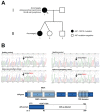Isolated familial somatotropinoma: 11q13-loh and gene/protein expression analysis suggests a possible involvement of aip also in non-pituitary tumorigenesis
- PMID: 20454499
- PMCID: PMC2862671
- DOI: 10.1590/S1807-59322010000400010
Isolated familial somatotropinoma: 11q13-loh and gene/protein expression analysis suggests a possible involvement of aip also in non-pituitary tumorigenesis
Abstract
Objective: Non-pituitary tumors have been reported in a subset of patients harboring germline mutations in the aryl hydrocarbon receptor-interacting protein (AIP) gene. However, no detailed investigations of non-pituitary tumors of AIP-mutated patients have been reported so far.
Patients: We examined a MEN1- and p53-negative mother-daughter pair with acromegaly due to somatotropinoma. Subsequently, the mother developed a large virilizing adrenocortical carcinoma and a grade II B-cell non-Hodgkin's lymphoma.
Design: Mutational analysis was performed by automated sequencing. Loss-of-heterozygosity (LOH) analysis was carried out by sequencing and microsatellite analysis. AIP expression was assessed through quantitative PCR (qPCR) and immunohistochemistry.
Results: The functional inactivating mutation c.241C>T (R81X), which blocks the AIP protein from interacting with phosphodiesterase 4A (PDE4A), was identified in the heterozygous state in the leukocyte DNA of both patients. Analyzing the tumoral DNA revealed that the AIP wild-type allele was lost in the daughter's somatotropinoma and the mother's adrenocortical carcinoma. Both tumors displayed low AIP protein expression levels. Low AIP gene expression was confirmed by qPCR in the adrenocortical carcinoma. No evidence of LOH was observed in the DNA sample from the mother's B-cell lymphoma, and this tumor displayed normal AIP immunostaining.
Conclusions: Our study presents the first molecular analysis of non-pituitary tumors in AIP-mutated patients. The finding of AIP inactivation in the adrenocortical tumor suggests that further investigation of the potential role of this recently identified tumor suppressor gene in non-pituitary tumors, mainly in those tumors in which the cAMP and the 11q13 locus are implicated, is likely to be worthwhile.
Keywords: AIP; Acromegaly; Adrenocortical tumor; FIPA; pituitary tumor.
Figures




Similar articles
-
Genetic analysis in a patient presenting with meningioma and familial isolated pituitary adenoma (FIPA) reveals selective involvement of the R81X mutation of the AIP gene in the pathogenesis of the pituitary tumor.Pituitary. 2012 Dec;15 Suppl 1:S61-7. doi: 10.1007/s11102-012-0391-y. Pituitary. 2012. PMID: 22527616
-
Screening for AIP gene mutations in a Han Chinese pituitary adenoma cohort followed by LOH analysis.Eur J Endocrinol. 2013 Oct 23;169(6):867-84. doi: 10.1530/EJE-13-0442. Print 2013 Dec. Eur J Endocrinol. 2013. PMID: 24050928
-
Germline mutation in the aryl hydrocarbon receptor interacting protein gene in familial somatotropinoma.J Clin Endocrinol Metab. 2007 May;92(5):1934-7. doi: 10.1210/jc.2006-2394. Epub 2007 Mar 6. J Clin Endocrinol Metab. 2007. PMID: 17341560
-
Familial isolated pituitary adenomas (FIPA) and the pituitary adenoma predisposition due to mutations in the aryl hydrocarbon receptor interacting protein (AIP) gene.Endocr Rev. 2013 Apr;34(2):239-77. doi: 10.1210/er.2012-1013. Epub 2013 Jan 31. Endocr Rev. 2013. PMID: 23371967 Free PMC article. Review.
-
Familial isolated pituitary adenomas (FIPA) and mutations in the aryl hydrocarbon receptor interacting protein (AIP) gene.Endocrinol Metab Clin North Am. 2015 Mar;44(1):19-25. doi: 10.1016/j.ecl.2014.10.002. Epub 2014 Nov 4. Endocrinol Metab Clin North Am. 2015. PMID: 25732638 Review.
Cited by
-
Emergence of Pituitary Adenoma in a Child during Surveillance: Clinical Challenges and the Family Members' View in an AIP Mutation-Positive Family.Int J Endocrinol. 2018 Apr 4;2018:8581626. doi: 10.1155/2018/8581626. eCollection 2018. Int J Endocrinol. 2018. PMID: 29849625 Free PMC article.
-
Molecular and genetic aspects of oncology and infectology in Clinics.Clinics (Sao Paulo). 2012 Dec;67(12):1353-6. doi: 10.6061/clinics/2012(12)01. Clinics (Sao Paulo). 2012. PMID: 23295585 Free PMC article. No abstract available.
-
MEN1, MEN4, and Carney Complex: Pathology and Molecular Genetics.Neuroendocrinology. 2016;103(1):18-31. doi: 10.1159/000371819. Epub 2015 Jan 9. Neuroendocrinology. 2016. PMID: 25592387 Free PMC article. Review.
-
Genetics and epigenetics of adrenocortical tumors.Mol Cell Endocrinol. 2014 Apr 5;386(1-2):67-84. doi: 10.1016/j.mce.2013.10.028. Epub 2013 Nov 9. Mol Cell Endocrinol. 2014. PMID: 24220673 Free PMC article. Review.
-
Narrowing the gap of personalized medicine in emerging countries: the case of multiple endocrine neoplasias in Brazil.Clinics (Sao Paulo). 2012;67 Suppl 1(Suppl 1):3-6. doi: 10.6061/clinics/2012(sup01)02. Clinics (Sao Paulo). 2012. PMID: 22584698 Free PMC article. Review.
References
-
- Melmed S. Medical progress: acromegaly. N Engl J Med. 2006;355:2558–73. - PubMed
-
- Vierimaa O, Georgitsi M, Lehtonen R, Vahteristo P, Kokko A, Raitila A, et al. Pituitary adenoma predisposition caused by germline mutations in the AIP gene. Science. 2006;312:1228–30. - PubMed
-
- Daly AF, Vanbellinghen JF, Khoo SK, Jaffrain-Rea ML, Naves LA, Guitelman MA, et al. Aryl hydrocarbon receptor-interacting protein gene mutations in familial isolated pituitary adenomas: analysis in 73 families. J Clin Endocrinol Metab. 2007;92:1891–96. - PubMed
-
- Soares BS, Frohman LA. Isolated familial somatotropinoma. Pituitary. 2004;7:95–101. - PubMed
-
- Daly AF, Tichomirowa MA, Beckers A. Genetic, molecular and clinical features of familial isolated pituitary adenomas. Horm Res. 2009;71:116–22. - PubMed
Publication types
MeSH terms
Substances
LinkOut - more resources
Full Text Sources
Medical
Research Materials
Miscellaneous

